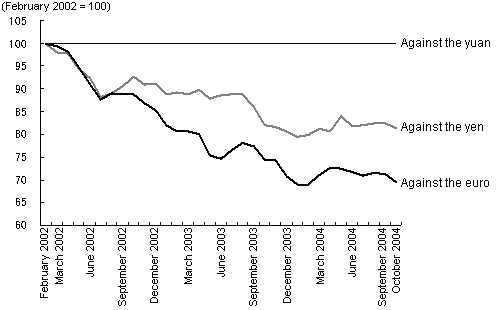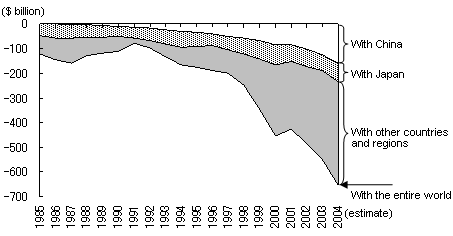The United States' trade deficit for January-September 2004 came to $469.5 billion; the figure for the full year is certain to top $600 billion, setting a record for the fourth straight year. Against this backdrop, doubts are rising over the sustainability of the external balance of the U.S., and the dollar is plunging against major currencies such as the yen and the euro ( figure 1 ). In order to stabilize the dollar against major currencies, the trade deficit needs to be covered by an equivalent amount of net capital inflow. However, foreign investors are slowing their dollar investments because of low interest rates in the U.S. and the risk of a decline in the currency. Instead, monetary authorities in countries such as Japan and China are intervening actively in the foreign exchange market to halt the dollar slide.
In fact, not only Japan and China but also other economies in East Asia are buying dollars in the foreign exchange market to keep their currencies from rising against the greenback. As a result, the foreign exchange reserves of East Asian economies (Japan, China, Taiwan, South Korea and Hong Kong) have roughly doubled from $938.2 billion at the end of 2001 to $1.825 trillion as of the end of July 2004. During the same period, the foreign exchange reserves of the euro zone countries have not shown any dramatic change, falling slightly from $235 billion to $225.9 billion, but instead the euro has surged against the dollar. Monetary authorities in Asia are now being forced to decide whether to continue to increase their foreign reserves or to allow their currencies to appreciate against the dollar.
Reflecting this trend toward a weak dollar, the Chinese yuan, which is in essence pegged to the greenback, is weakening against non-dollar currencies. Although this boosts the competitiveness of China's exports, it could lead to trade friction as the country's trade surplus balloons. In fact, since 2000, China has overtaken Japan to become the largest source of U.S. trade deficit ( figure 2 ). As the trade imbalance between China and the U.S. continues to widen, Washington has stepped up pressure on China to allow the yuan to appreciate.
So long as the Chinese authorities try to maintain the dollar peg, they will have to intervene in the market to offset the current account surplus (mainly reflecting surplus in its trade account) and the capital account surplus (mainly reflecting the inflow of foreign direct investment). As a result, China's foreign exchange reserves have been rising rapidly, reaching $514.5 billion in September 2004. In the first nine months of this year alone China amassed $111.3 billion in reserves. Although the authorities have not disclosed how these rapidly growing foreign reserves are being invested, it is likely that a fair amount has been pumped into dollar-denominated assets such as Treasury securities. Some Chinese scholars argue the increase in China's foreign exchange reserves amounts to an extension of loans to the U.S. and that this gives China an a leverage in bilateral negotiations on such issues as trade. However, with most of its foreign exchange reserves invested in dollar-denominated assets, China will incur huge losses if the dollar's value plunges. Taking into account the fact that China's gross domestic product is just one-eighth that of the U.S., its holdings of Treasuries, far from being a trump card in negotiations, may actually be taken hostage by the U.S.
In order to resolve this problem, the Chinese authorities should gradually shift to a floating exchange rate regime that keeps market intervention to a minimal. If a currency basket system is introduced during the transition phase, China will be able to limit the adverse effects of exchange rate fluctuations among major currencies such as the dollar, the yen, the euro. Meanwhile, China also needs to revise the currency composition of its foreign exchange reserves. As the dollar is likely to continue its downward trend over the long-term, China needs to shift more of its reserves from dollar-denominated assets to assets denominated in yen or euro. Of course as the country adjusts its portfolio of currency holdings, the large volume of dollar-based asset sales could accelerate the dollar decline in the short term. However, over the long term, such a portfolio adjustment is unavoidable.

(Source)CEIC database

(Note)Figure for 2004 is an estimate based on Jnuary-September figures.
(Source)U.S. Census Bureau


